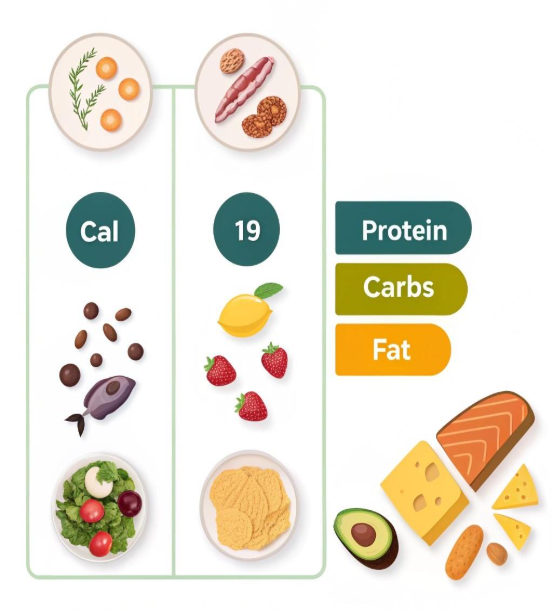Focus Keyword: macro and calorie tracking
Secondary Keywords: how to track food, fat loss macros
Whether you’re looking to lose body fat, gain muscle, or just stay healthy and at a good body weight, one of the most powerful weapons in your arsenal is calorie and macro tracking. This will enable you to know what you’re consuming, how much, and how it affects your body.

In this comprehensive guide, we’ll walk you through how to count calories, track macros, and simplify it with tools and pro tips—so you can move confidently towards your fitness goals.
What Are Calories and Macros?
Let’s get the what out of the way before we dive into the how:
Calories
Calories are a measure of energy. Your body requires energy to do everything—whether it’s walking, breathing, or metabolizing food. You gain weight if you consume more calories than your body expends. You lose weight if you consume less.
Macronutrients (Macros)
There are three primary macronutrients, each with a unique function:
Carbohydrates: Your body’s go-to source of energy
1g = 4 calories
Protein: Muscles grow and repair, satisfies hunger
1g = 4 calories
Fats: Facilitates hormones and absorbs vitamins
1g = 9 calories
Tracking macros is tracking how your calories are divided among these nutrients—which is essential for fat loss, muscle growth, and energy regulation.
Why Calorie and Macro Tracking Matters?
No matter if you’re on Keto, Paleo, Vegan, or any other diet plan, what actually creates success is your calorie balance and macro breakdown.
Advantages of Tracking:
- You know exactly what you’re consuming
- Maintain a calorie deficit for fat loss
- Make sure you have sufficient protein to keep the muscle
- Tune in according to performance or energy level
- Recognize and overcome plateaus
A review published in the American Journal of Clinical Nutrition found that those who monitored their food consumption lost more weight compared to those who didn’t.

Step 1: Calculate Your Daily Calorie Needs |macro and calorie tracking
You have to determine how much you are supposed to eat before you can begin tracking food.
Utilize This Formula:
1. Approximate your Total Daily Energy Expenditure (TDEE):
Utilize an online TDEE calculator or the Mifflin-St Jeor equation:
TDEE = BMR × Activity Level
Example:
Sedentary (little or no exercise): BMR × 1.2
Light exercise (1–3 days/week): BMR × 1.375
Moderate exercise (3–5 days/week): BMR × 1.55
Very active (6–7 days/week): BMR × 1.725

2. Determine Your Goal:
Fat Loss: Consume 15–25% less than your TDEE
Muscle Gain: Consume 10–20% more than your TDEE
Maintenance: Equal your TDE
Pro Tip: For fat loss, maintain a moderate calorie deficit (e.g., 300–500 calories/day). Greater deficits can slow down metabolism or lead to muscle loss.
Step 2: Determine Your Macro Ratios
Now that you know how many calories you require, it is time to allocate them into macros.
Popular Macro Ratios for Fat Loss:
| Goal | Protein | Carbs | Fat |
| Fat Loss | 40% | 30% | 30% |
| Muscle Gain | 30% | 40% | 30% |
| Balanced Diet | 33% | 33% | 33% |
Suppose your daily target is 1,800 calories for fat loss:
Protein: 40% = 720 cal → 180g
Carbs: 30% = 540 cal → 135g
Fat: 30% = 540 cal → 60g

Macro Tracking Tip: Prioritize protein to maintain muscle while losing fat.
Step 3: Use a Tracking App
One of the most convenient ways to track food and macros is via mobile apps.
✅ Top Recommended Apps:
MyFitnessPal (Beginner-friendly)
Cronometer (Excellent for tracking micronutrients)
Lose It!
MacroFactor (Premium but extremely accurate)
These apps enable you to:
Scan barcodes of packaged foods
Log recipes and meals
Track daily calorie and macro consumption
Monitor long-term progress
Pro Tip: Pre-log your meals in the morning or at night before to stay on track.
Step 4: Measure and Weigh Your Food
Eyeballing portions won’t cut it—accuracy is essential if you want to see results.
Must-Have Tools:
Digital kitchen scale (for gram-accurate portions)
Measuring cups/spoons
Food labels and app entries
Always weigh raw food unless the package indicates “cooked.” Weight changes with cooking, particularly in rice, chicken, and pasta.
Step 5: Learn Food Labels and Serving Sizes
Reading food labels is crucial to precise calorie and macro monitoring.
Check for:
Serving size (usually less than you expect)
Calories per serving
Macronutrient composition (protein, fat, and carb grams)
Hidden sugars or fats
Don’t be fooled by marketing such as “low-fat” or “high-protein” without looking at the complete nutritional information.
Rebalance as You Go
As your weight fluctuates, so does your caloric demand. Recalculate your TDEE every 4–6 weeks and rebalance your intake if:
Weight loss plateau for 2+ weeks
Energy or performance dips
You’re gaining weight unintentionally
Plot trends over 7–10 days, not day-to-day variability.
Example Day: Calorie and Macro Tracking for Fat Loss
Suppose your target:
1800 calories – 180g protein, 135g carbs, 60g fat
Sample Meal Plan:
Breakfast:
3 eggs, 1 slice whole wheat toast, ½ avocado
(Protein: 18g | Carbs: 15g | Fat: 20g)
Lunch:
Grilled chicken breast, 1 cup quinoa, steamed broccoli
(Protein: 35g | Carbs: 40g | Fat: 12g)
Snack:
Protein shake with almond milk and peanut butter
(Protein: 30g | Carbs: 10g | Fat: 10g)
Dinner:
Baked salmon, roasted sweet potato, mixed greens with olive oil
(Protein: 35g | Carbs: 30g | Fat: 18g)
Evening snack:
Greek yogurt and berries
(Protein: 15g | Carbs: 20g | Fat: 5g)
Tips to Make Macro Tracking Easy
Repeat meals – Prep 2–3 meals in batches and rotate
Use a food diary – Even on paper, it creates awareness
Pre-track treats – Work desserts into your macros rather than “cheating”
Scan barcodes – It’s quicker and minimizes entry errors
Be consistent, not perfect – Track at 80–90% accuracy
Tracking Tips and Expert Advice
At TitanFit.co.in, we recommend evidence-based approaches to weight loss and muscle gain. Calorie and macro tracking might initially feel cumbersome, but it creates consciousness that can revolutionize the way you eat for the rest of your life.
If you have medical conditions, are underweight, or have a history of disordered eating, see a registered dietitian or healthcare professional before trying calorie control.
Final Thoughts: Is Calorie and Macro Tracking Right for You?
Calorie and macro tracking isn’t about restriction—it’s about precision. Whether your target is fat loss, muscle gain, or improved energy, tracking gives you insight and control.
- You’ll learn how food fuels your body
- You’ll eat more mindfully and intentionally
- You’ll reach your fitness goals faster and smarter
- Start simple, stay consistent, and don’t let perfection stop your progress.



